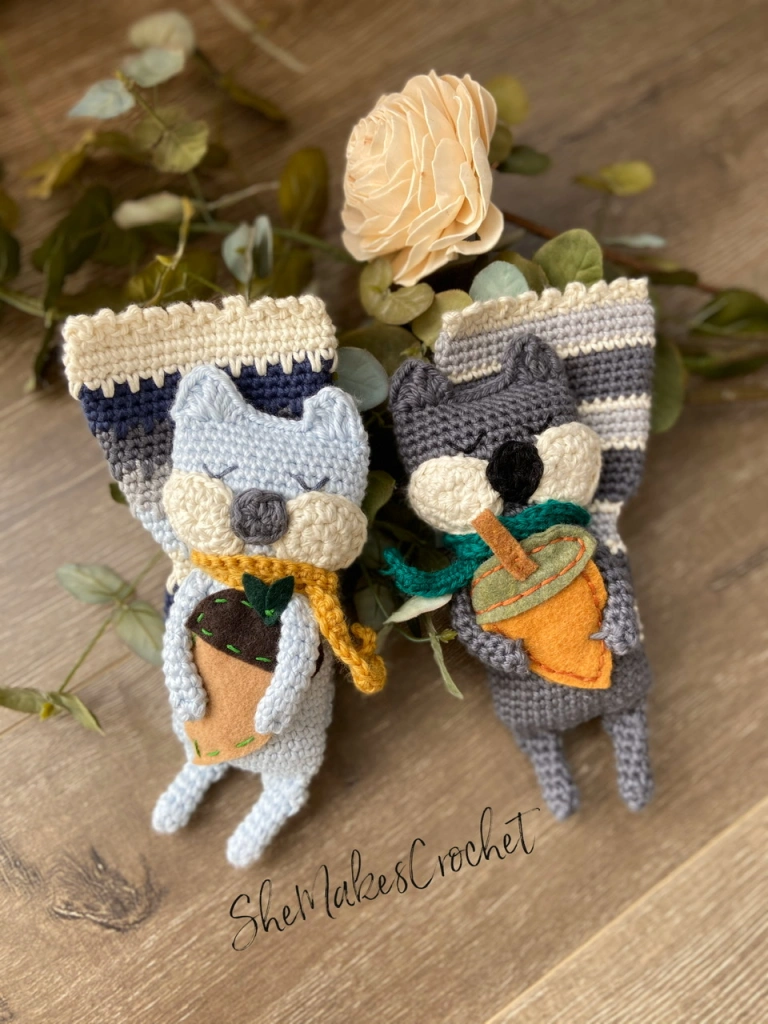
I’m so happy to share my Rag Doll Squirrel! My toddler loves squirrels and so you can imagine, I’ve had a lot of time to study them as we watch them run around whenever we encounter them. One day, as my children excitedly watched the squirrels, I began to realize that a squirrel would be the perfect addition to my collection and I couldn’t wait to figure out something fun to do with the tail. I really love how these turned out, though I must admit, if I was able to get to the craft store, I would have considered doing the tail in a plaid print fabric, but I don’t have any. Not to mention, that may be too ambitious for my sewing level. Just a thought, in case anyone wants to try it and report back to us!

Now is the point where I mention that if you like this little guy, I have several other similar style dolls – a Bunny, Bear, Fox and now this Squirrel. I have quite the little group of forest friends going on and they are adorable as a set. You definitely need more than one of these.
A final note, I call these rag dolls because I very much love those 2-D fabric rag dolls, but my sewing skills are so-so, so I’ve never made one. My dolls are made amigurumi style, but they all have a flat look to them and I try to keep the silhouette very simple. I also try hard to make these in one piece. I will confess that my squirrel does require the tail to be sewn on at the end – it’s just too big and prominent to do it any differently. You finish these off with a simple face and then add accessories, colors and textures that really elevate the simple body shape without being over-the-top. I hope these dolls inspire you to add your own personal touches because that’s really where the character comes from!
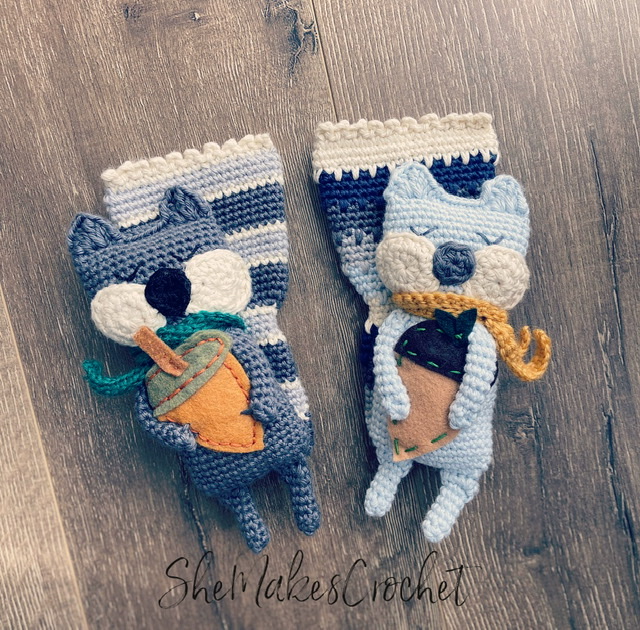
Rag Doll Squirrel
Supplies:
- Worsted weight yarn for the fox and contrasting yarn for the cheeks, tail and nose – I used I Love this Cotton
- Contrasting yarn for the scarf – I used Paton’s Classic Wool DK Superwash
- 3.5 mm crochet hook
- Scissors
- Needle for sewing down yarn tails
- Stitch marker (or scrap of yarn) – optional
- Poly-fil or stuffing of choice
- Embroidery floss
- Needle for embroidery details
- Small piece(s) of felt (for the acorn)
Finished Dimensions: My squirrels are 8.5 inches tall with extended legs to the highest point of the tail.
Abbreviations and stiches used:
- CH chain
- SC single crochet
- HDC half double crochet
- DC double crochet
- TR treble crochet
- SS slip stitch
- INC increase (i.e. work 2 SC in the same stitch)
- DEC ***decrease (i.e. work 1 SC over two stitches)***
- FLO front loop only
- BLO back loop only
***Please note, with amigurumi, I recommend making an invisible decrease. See pattern notes if you are unsure of the difference.***
Pattern Notes:
The arms, legs and tail are not stuffed which adds to that loose, floppy feel. The body/head is stuffed at the very end and while it’s recommended to stuff firmly, don’t go overboard with this! You want a nice soft, squish to your doll.
The arms and legs are closed off before working into the body (to keep the stuffing out and to add to the floppy feel). Please reference the closing off instructions below as the pattern will direct you to them later.
Closing Off
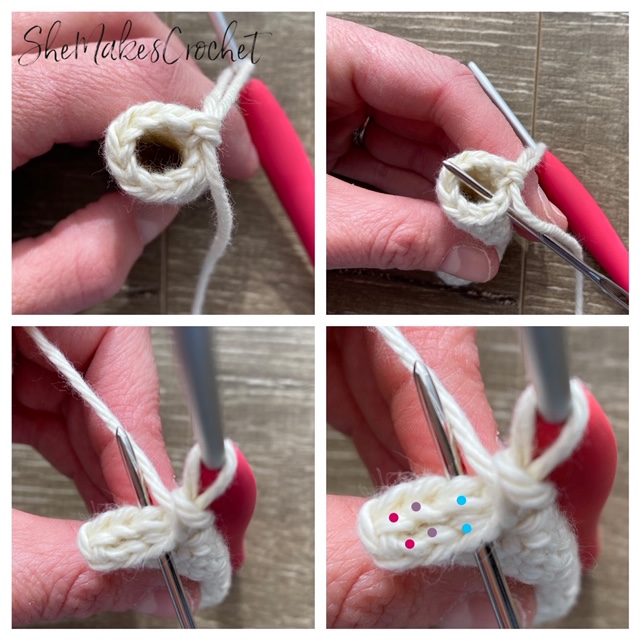
In essence, you will squish the tube flat. There will be 1 unworked stitch on either end and then you will work a SC stitch through stitches on both sides of the tube converting the tube into a single row of stitches.
Image 1: depicts a limb worked through the end, i.e. the tube, in this case, of 10 stitches.
Image 2: the needle is serving as a place holder for the skipped stitch. You will insert your hook into the first stitch after the needle AND into the last stitch you just created to work your first SC. Note: the squirrel legs are slightly different and the pattern will highlight that difference.
Image 3: shows what your limb will look like after making that first SC through both layers of the tube and the needle highlights the two stitches you will insert your hook into to work the next SC.
Image 4: further clarifies the 4 SC stitches you will complete and as you can see, after you work the blue, purple and pink stitches, there will be 1 stitch left unworked on the end.
Attaching the Arms
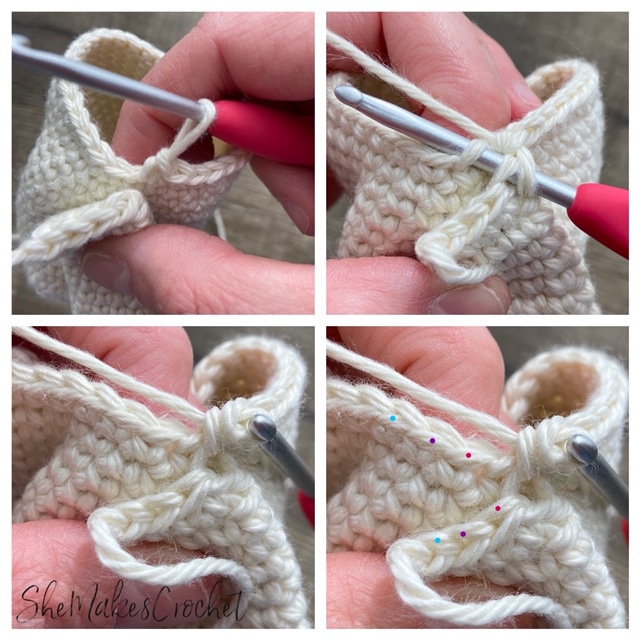
These images illustrate attaching an arm with a final stitch count of 4. Please note that the process for attaching the squirrel arms is exactly the same, only working with less stitches (i.e. 2).
Image 1: shows how you will pick up the arm to work the next four stitches of the body and the 4 stitches at the top of the arm simultaneously to attach.
Image 2: illustrates inserting your hook through the BLO of the first stitch of the arm and the FLO of the next stitch of the body.
Image 3: depicts what it looks like after making the first stitch to attach the arm.
Image 4: shows where you will work the remaining three stitches, again through the BLO of the arm and FLO of the body in order to finish attaching the arm.
Finally, the invisible decrease is recommended as it’s usually neater with this style of crochet. There are lots of great tutorials out there if you need more help. Briefly, insert your hook into the FLO of the next stitch, DO NOT draw up a loop and instead, insert your hook into the FLO of the next stitch after that. It’s a little awkward at first, but you’ll get use to it. Then, yarn over and pull through two loops (i.e. the two front loops) and then yarn over and pull through to complete the stitch.
Pattern:
Make the arms
Using main color.
- Round 1: Magic ring and SC 6. Pull ring tight. (6 SC)
- Rounds 2-10: SC all around. (6 SC)
- Round 11: Close off by making 2 SC stitches – see Closing Off instructions above if unsure.
- Break the yarn and set aside for now. Make two.
Make the legs
Using main color.
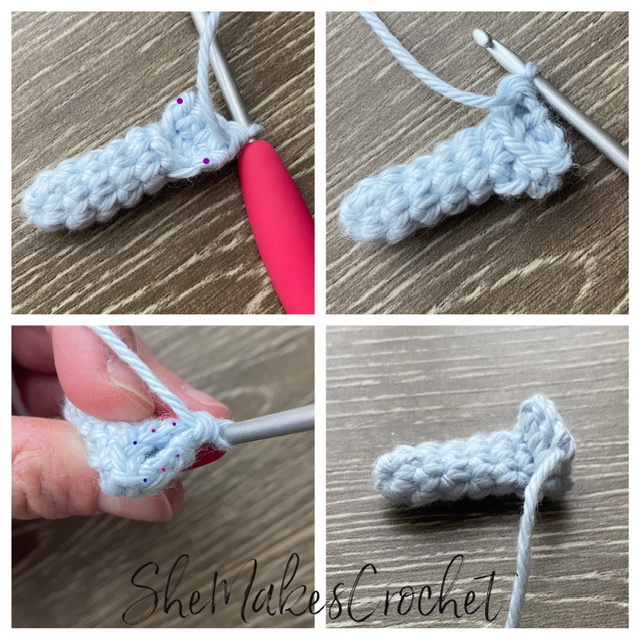
Image 1: illustrates (purple dots) what I mean when I say SC down and then later up the edge.
Image 2: shows how things should look after working Round 8.
Image 3: purple, pink and blue dots are meant to illustrate the three pairs of stitches you will work into to create the bend. This is very similar to how you closed off the arms, just note that for neatness, the unworked stitches should be the two stitches you made at the edges.
Image 4: finished foot with the bend/joint at the top.
- Round 1: Magic ring and SC 6. Pull ring tight. (6 SC)
- Rounds 2-6: SC all around. (6 SC)
- Round 7: CH 1, turn and SC in the first three stitches. Note: this is an incomplete round.
- Round 8: CH 1, turn and SC 3. CH 1 and work 1 SC down edge, SC in next three stitches and work 1 SC up edge. (8 SC)
- Round 9: Close off by making 3 SC stitches – see Closing Off instructions above if unsure.
Note: the one SC stitch along the edges will be the unworked stitches so you will insert your hook into the NEXT stitch and instead skip the last stitch you just made which is slightly different than what you did for the arm. - Break the yarn and complete a second leg – do NOT fasten off after completing the second leg.
Continue on to the body
First we will attach the legs before working the body.
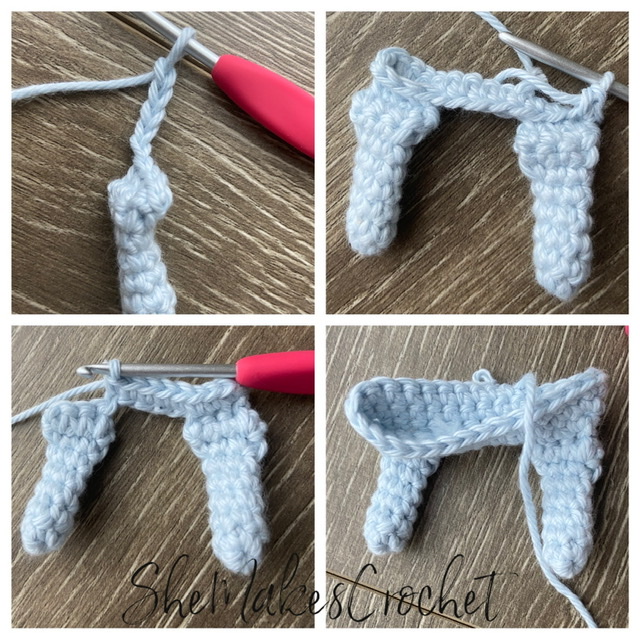
Image 1: shows the second leg and CH 5.
Image 2: is worked through making stitches around the first leg, and into the FLO of the CH 5, back to the second leg (starting leg) and making both INC stitches. You can see the unworked BLO (that are now in the front) for the last two stitches of the leg, as well as the CH 5.
Image 3: illustrates the end of Round 1.
Image 4: after working several rounds/stitches to show how the legs bend in relation to the body.
- Round 1: CH 5. Pick up second leg and SC in FLO of the first two stitches. INC in last FLO, rotate work and INC in same stitch (i.e. the BLO of the previous stitch which is now facing to the front). SC in next two FLO. SC in FLO of next five CH and SC in next two FLO of first leg. INC in last FLO. Rotate work and INC in same stitch (i.e. the BLO of previous stitch which is now facing to the front). SC in next two FLO and into the backside of the next five CH. (26 SC)
It may be helpful (or not) to mark the first stitch of each round as we will be working in continuous rounds.
- Round 2: SC 3, INC, INC, SC 11, INC, INC, SC 8. (30 SC)
- Rounds 3-15: SC all around. (30 SC)
- Round 16: SC 6, DEC, SC 14, DEC, SC 6. (28 SC)
- Round 17: SC all around. (28 SC)
- Round 18: SC 6, DEC, SC 12, DEC, SC 6. (26 SC)
Note: you will be attaching the arms during this round. See pattern notes above for more details.
- Round 19: SC 5, DEC, DEC, attach the arm over the next two stitches by inserting your hook into the BLO of the next stitch of the arm and the FLO of the next stitch of the body. SC 6, attach the arm over the next two stitches by inserting your hook into the BLO of the next stitch of the arm and the FLO of the next stitch of the body – Note: when attaching the second stitch of the arm, you need to work a decrease i.e. insert your hook into BLO of the second stitch of the arm and then work an invisible decrease in the FLO of the next two stitches of the body. Then, DEC , SC 4. (22 SC)
- Round 20: SC 4, DEC, DEC, SC 8, DEC, DEC, SC 2. (18 SC)
Continue on to the head
- Round 21: SC 4, INC, INC, SC 8, INC, INC, SC 2. (22 SC)
- Round 22: SC 5, INC, INC, SC 10, INC, INC, SC 3. (26 SC)
- Round 23: SC 7, INC, INC, SC 10, INC, INC, SC 5. (30 SC)
- Round 24: SC 8, INC, INC, SC 13, INC, INC, SC 5. (34 SC)
- Rounds 25-30: SC all around. (34 SC)
- Round 31: SC 10, DEC, SC 15, DEC, SC 5. (32 SC)
- Round 32: SC all around. (32 SC)
- Round 33: SC 10, DEC, SC 14, DEC, SC 4. (30 SC)
Continue on to the first ear
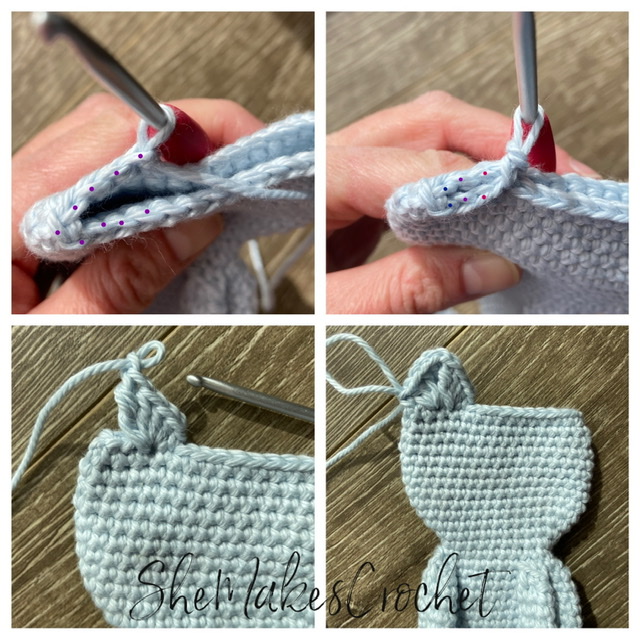
Image 1: shows turning your work prior to making any stitches. The purple dots depict counting 9 stitches.
Image 2: illustrates after working the first SC through the 9th stitch and the last stitch you made. The pink, purple and blue dots show the remaining pairs of stitches you will work into to create the ear. Note that there is one unworked stitch at the side.
Image 3: after working the ear through the CH 1. Note at this point, you have two more stitches remaining and the first of the two can be somewhat buried under that first group of stitches.
Image 4: first ear complete.
Now is a great time to stuff your work. Be sure and stuff all the way to the bottom.
- Round 1: Turn your work and count backwards 9 stitches (and mark if needed). Start closing off the head/working the first ear by inserting your hook into the 9th (marked stitch) and the last stitch you just made in order to work a SC. In the next stitch, work the following [HDC 2, DC, TR, CH 1], in the next stitch work the following (Hint: it may be hidden.) [ TR, DC, HDC 2], and work a SC in the last stitch. Hint: there will be one stitch on the side that is unworked.
- Fasten off.
Continue on to the second ear

Image 1: shows hook placement for first stitch with one unworked stitch at the side.
Image 2: shows first stitch of second ear made.
Image 3: after working the second group of stitches, just prior to working the remaining 7 SC. Note that the first stitch may be hidden under the group of stitches you just completed.
Image 4: view from the top. Continue making SC stitches through both sides to close off the head.
- Round 1: With the right side facing you, insert your hook into the first pair of stitches at the opposite side of the head. Hint: It’s 10 stitches away. As always, there will be one unworked stitch at the side. SC into the first pair. Then, in the next stitch work the following [HDC 2, DC, TR, CH 1], in the next stitch work the following [ TR, DC, HDC 2], SC in the remaining 7 stitches. Hint: the first stitch may be hidden. SS into the first SC of the first ear.
- Fasten off.
Create the tail
- Round 1: CH 12, INC in second CH from hook, SC in next 9, INC in last CH. Rotate your piece and work in the back loops of the starting CH. INC in the first CH, i.e. the same CH you previously increased in. SC in next 9, INC in the last, SS to join to first SC and CH 1. (26 SC)
- Rounds 2-15: SC all around, SS to join to first SC and CH 1. (26 SC)
- Round 16: SC, DEC, SC 12, DEC, SC 9, SS to join to first SC and CH 1. (24 SC)
- Round 17: SC, DEC, SC 10, DEC, SC 9, SS to join to first SC and CH 1. (22 SC)
- Round 18: DEC, SC 9, DEC, SC 9, SS to join to first SC and CH 1. (20 SC)
- Round 19: SC all around, SS to join to first SC and CH 1. (20 SC)
Round 20: INC, INC, SC 9, INC, INC, SC 7, SS to join to first SC and CH 1. (24 SC) - Round 21: SC, INC, INC, SC 11, INC, INC, SC 8, SS to join to first SC and CH 1. (28 SC)
- Round 22: SC 2, INC, INC, SC 13, INC, INC, SC 9, SS to join to first SC and CH 1. (32 SC)
- Rounds 23-26: SC all around, SS to join to first SC and CH 1. (32 SC)
- Round 27: SC 4, INC, SC 15, INC, SC 11, SS to join to first SC and CH 1. (34 SC)
- Rounds 28-29: SC all around, SS to join to first SC and CH 1. (34 SC)
Round 30: SC 5, INC, SC 16, INC, SC 11, SS to join to first SC and CH 1. (36 SC) - Rounds 31-32: SC all around, SS to join to first SC and CH 1. (36 SC)
- Round 33: SC 6, INC, SC 17, INC, SC 11, SS to join to first SC and CH 1. (38 SC)
- Rounds 34-35: SC all around, SS to join to first SC and CH 1. (38 SC)
- Round 36: SC 7, INC, SC 18, INC, SC 11 SS to join to first SC and CH 1. (40 SC)
- Rounds 37-39: SC all around, SS to join to first SC and CH 1. (40 SC)
- Fasten off.
Note: I experimented with stuffing my tail and ultimately decided to leave it unstuffed – I want my dolls flat. You could, however, stuff yours now if you prefer.
Close off the tail
See Closing Off instructions in Pattern Notes if unsure.
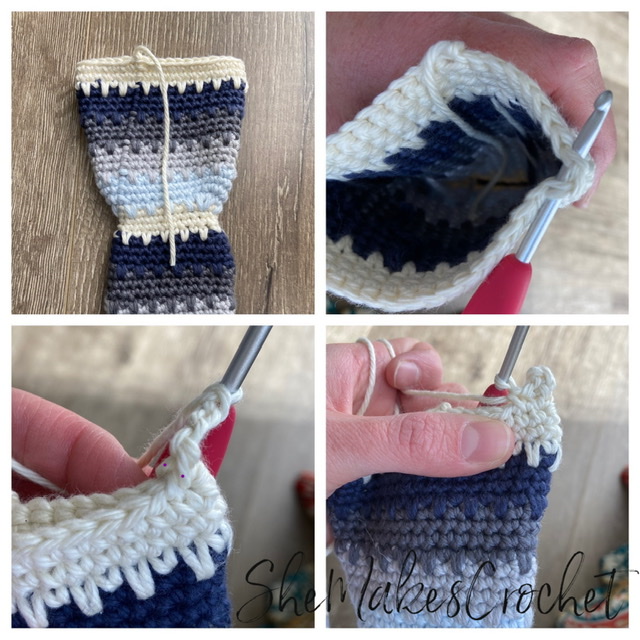
Image 1: tail is fastened off and squished just prior to working stitches through both sides of the tail.
Image 2: hook placement to work the first stitch. Note that there is one unworked stitch at the side.
Image 3: CH 3 and purple dots illustrate hook placement to SS to create picot (optional)
Image 4: completed first SC with CH 3 picot and SC repeat.
If you like the frilly top to my squirrels:
*SC, CH 3 and SS into the side of SC (making a picot), SC in next. Repeat from *until the end. Fasten off and weave in any ends.
If you like the stripes for my squirrels:
Grey squirrel – 5 rounds of grey (main color), 1 round cream (cheek color), 3 rounds light grey (accent color), 1 round cream. Repeat the color sequence until the end.
Blue squirrel – 4 rounds light blue (main color), 4 rounds light grey (accent color), 4 rounds grey (accent color), 4 rounds dark blue (accent color), 4 rounds cream (cheek color). Repeat the color sequence. On the first round of every color change, alternate a SC stitch and an extended SC stitch – this is a little tricky on the INC/DEC rounds so be extra mindful counting stitches.
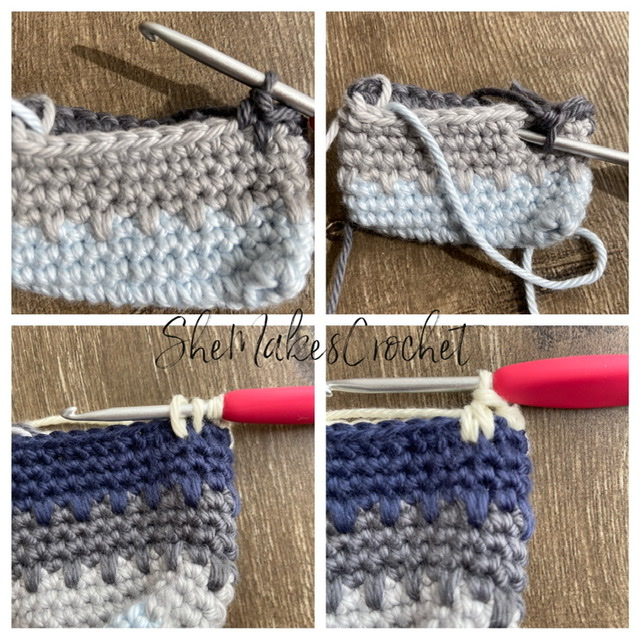
Images 1 and 2 show hook placement for working alternating extended SC and SC stitches for the first round of every color change.
Images 3-4: show that sometimes you will need to make an extended SC as a DEC and as such, will need to work into two stitches.
Stitch the tail to the body
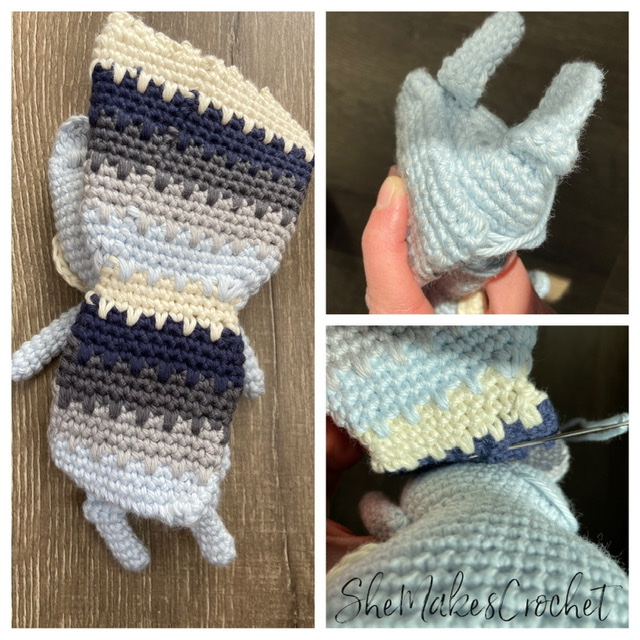
The image on the left shows how I positioned my tail at an angle prior to stitching – so it would be sticking out off to the side.
Right side images show sewing the tail into place. I stitched across the bottom and then made several stitches randomly in the middle up the length of the tail to tack down further up the body. I did this through one panel of the tail only, i.e. I didn’t insert the needle completely through the tail.
Add the Details:
This is always my favorite part about making dolls, but I know that’s not the case for everyone! All of these features are optional and can be modified based on your ability and preference. For example, you could use felt for the cheeks and the nose and/or make a scarf out of fabric. You could crochet an acorn or leave it off entirely.
Crochet the cheeks
Using contrasting color.
- Round 1: Magic ring and work 8 HDC, SS to join to first HDC and CH 1. Pull ring tight. (8 HDC)
- Round 2: HDC INC in each stitch around and SS to join to first HDC. (16 HDC)
- Round 3: SC in next (not first) stitch. HDC INC, HDC, HDC INC, SC, SS loosely in each stitch for the remainder of round. SS to join to first SC. (18 stitches)
- Fasten off leaving a long tail for sewing. Make two.
Crochet the nose
Using nose color.
- Round 1: Magic ring and work 8 HDC, SS to join to first HDC. Pull ring tight. (8 HDC)
- Fasten off and leave a long tail for sewing.
Create the face

Using the yarn tails, stitch the cheeks into place on the face using the image above as a guide. I left a gap of a couple of stitches between the cheeks.
Center the nose over the cheeks and stitch into place using the long tail.
Embroider the eyes. I recommend using a sharp needle so you can pierce through the yarn fibers easily. I stitch a long straight line. Then, I pull the stitch loose and into a “U” shape, next, tack the bottom of the “U” down with a very tiny stitch.
Crochet the scarf
Using scarf color
- Row 1: CH 76 and SC into second CH from hook and into each remaining CH. (75 SC)
- Break yarn. Weave in ends.
Make the acorn
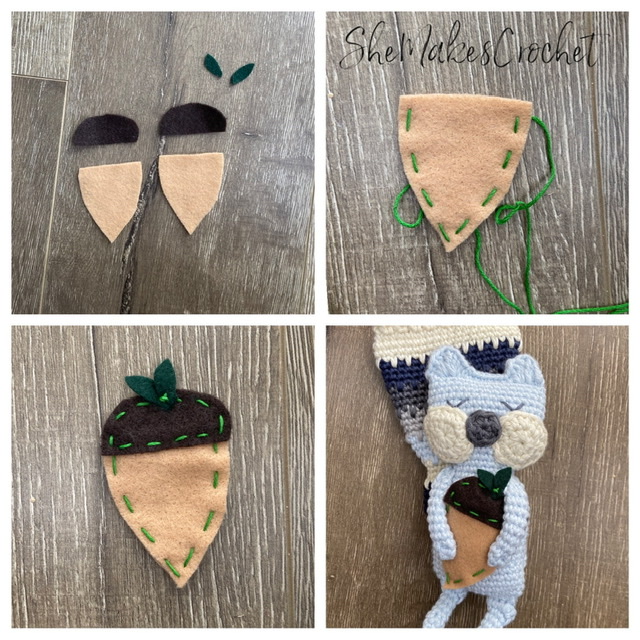
I used some scraps of felt to cut out an acorn, cap and stem/leaves. I eyeballed this and cut two pieces at one time so I could double layer my acorn. Which is optional, but I think makes things more sturdy. I also really exaggerated the size of my acorn because I think the larger scale is cute.
Use embroidery floss to stitch the two pieces together and then make a tiny stitch to adhere the arms to the acorn.
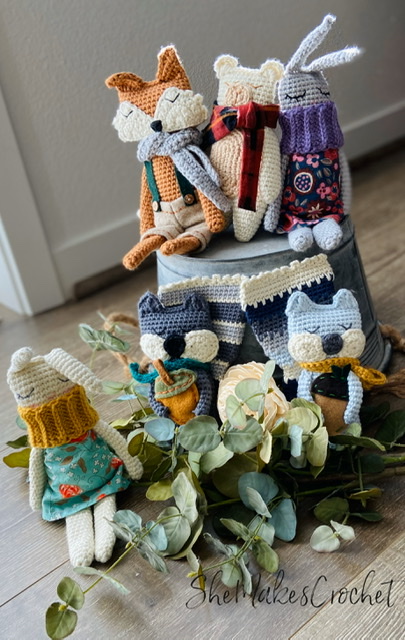
I love when people share their finished pieces. If you share your work on facebook or instagram, please tag me so I can see it @shemakescrochet.
You are free to share your finished work, to include selling your finished products, but please credit me – SheMakesCrochet – as the pattern designer. Please do not distribute this pattern or any portion of it, instead direct people to my blog. THANK YOU!



3 thoughts on “Rag Doll Squirrel”